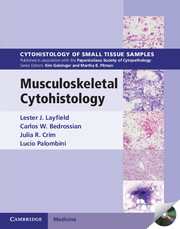Book contents
- Frontmatter
- Contents
- 1 Principles and practice for biopsy diagnosis and management of musculoskeletal lesions
- 2 Ancillary techniques useful in the evaluation and diagnosis of bone and soft tissue neoplasms
- 3 Spindle cell tumors of bone and soft tissue in infants and children
- 4 Spindle cell tumors of the musculoskeletal system characteristically occurring in adults
- 5 Giant cell tumors of the musculoskeletal system
- 6 Myxoid lesions of bone and soft tissue
- 7 Lipomatous tumors
- 8 Vascular tumors of bone and soft tissue
- 9 Pleomorphic sarcomas of bone and soft tissue
- 10 Osseous tumors of bone and soft tissue
- 11 Cartilaginous neoplasms of bone and soft tissue
- 12 Small round cell neoplasms of bone and soft tissue
- 13 Epithelioid and polygonal cell tumors of bone and soft tissue
- 14 Cystic lesions of bone and soft tissue
- Index
9 - Pleomorphic sarcomas of bone and soft tissue
Published online by Cambridge University Press: 05 September 2013
- Frontmatter
- Contents
- 1 Principles and practice for biopsy diagnosis and management of musculoskeletal lesions
- 2 Ancillary techniques useful in the evaluation and diagnosis of bone and soft tissue neoplasms
- 3 Spindle cell tumors of bone and soft tissue in infants and children
- 4 Spindle cell tumors of the musculoskeletal system characteristically occurring in adults
- 5 Giant cell tumors of the musculoskeletal system
- 6 Myxoid lesions of bone and soft tissue
- 7 Lipomatous tumors
- 8 Vascular tumors of bone and soft tissue
- 9 Pleomorphic sarcomas of bone and soft tissue
- 10 Osseous tumors of bone and soft tissue
- 11 Cartilaginous neoplasms of bone and soft tissue
- 12 Small round cell neoplasms of bone and soft tissue
- 13 Epithelioid and polygonal cell tumors of bone and soft tissue
- 14 Cystic lesions of bone and soft tissue
- Index
Summary
INTRODUCTION
Cells and tissue sampled from this group of neoplasms is easily recognized as malignant but definitive subtyping is often difficult or impossible. The majority of sarcomas falling within this group are pleomorphic liposarcomas and neoplasms originally designated as pleomorphic malignant fibrous histiocytomas. The latter group is now more commonly designated as pleomorphic undifferentiated sarcoma (PLUS). This designation is given after extensive immunohistochemical and even molecular diagnostic studies have failed to determine a precise histologic type.
Sarcomas within this category can be confused with melanoma and anaplastic carcinoma. Lymphomas rarely enter the differential diagnosis of pleomorphic sarcoma but pleomorphic carcinomas from a variety of sites may enter the differential diagnosis for material aspirated from these neoplasms. Pleomorphic, giant cell, and sarcomatoid carcinomas occur in the lung, kidney, thyroid, and pancreas. Clinical history, immunohistochemistry, and molecular diagnostics are often of help in recognizing carcinomas within the differential diagnosis of pleomorphic sarcoma.
In addition to pleomorphic liposarcomas and pleomorphic high grade sarcoma (malignant fibrous histiocytoma), pleomorphic rhabdomyosarcoma, dedifferentiated liposarcoma, dedifferentiated chondrosarcoma, pleomorphic leiomyosarcoma, and some cases of malignant mesenchymoma fall within this category. The majority of these sarcomas occur in adults, often in late adult life.
- Type
- Chapter
- Information
- Musculoskeletal Cytohistology , pp. 183 - 197Publisher: Cambridge University PressPrint publication year: 2000



